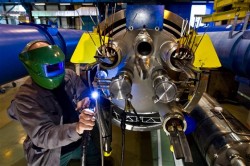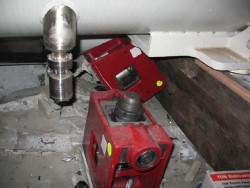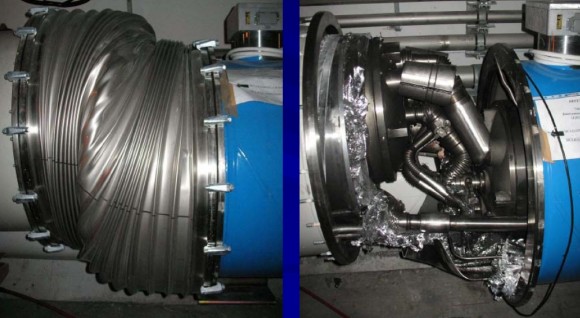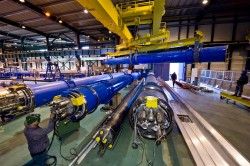[/caption]On September 19th, CERN announced that the Large Hadron Collider had suffered a major incident, known as a “quench”. An electrical short between two of the superconducting magnets had kick-started a helium coolant leak inside the tunnels housing the accelerator ring. The quench caused the magnets to rapidly heat up, severely damaging them. The violent release of coolant ripped equipment from their concrete anchors, ensuring a huge repair operation would need to be carried out. However, it was a while before engineers were able to access the damage and the news wasn’t good: The LHC would be out of commission until the spring of 2009 at the earliest. That was such a sad day.

In addition to these images, there are suggestions that there may be no particle collisions next year. Although the most recent report doesn’t appear to back up these plans, and replacement parts have started to arrive at the facility (above), it looks like the first collisions probably won’t happen until July 2009 at the earliest (that’s four months later than previously estimated)…

Within the first second, an electrical arc developed and punctured the helium enclosure, leading to release of helium into the insulation vacuum of the cryostat. The spring-loaded relief discs on the vacuum enclosure opened when the pressure exceeded atmospheric, thus relieving the helium to the tunnel. They were however unable to contain the pressure rise below the nominal 0.15 MPa absolute in the vacuum enclosures of subsector 23-25, thus resulting in large pressure forces acting on the vacuum barriers separating neighboring subsectors, which most probably damaged them. These forces displaced dipoles in the subsectors affected from their cold internal supports, and knocked the Short Straight Section cryostats housing the quadrupoles and vacuum barriers from their external support jacks at positions Q23, Q27 and Q31, in some locations breaking their anchors in the concrete floor of the tunnel. The displacement of the Short Straight Section cryostats also damaged the “jumper” connections to the cryogenic distribution line, but without rupture of the transverse vacuum barriers equipping these jumper connections, so that the insulation vacuum in the cryogenic line not degrade.
–Robert Aymar, Status of CERN Activities, page 15.
The first image (pictured above) clearly shows the extent of the concrete damage that occurred during the huge pressure forces generated by the leaking helium, ripping the electromagnets off their supports (the red boxes in the photo) and shattering the floor.

In this second image, the extent of the damage is pretty clear. Assuming the accelerator beam-line used to be straight (unfortunately, there is no “before” picture), the violent displacement of a huge magnet (weighing several tonnes) is obvious.
Later in the presentation, Aymar points out that 5 quadrupole and 24 dipole magnets need to be repaired and around 57 magnets have to be removed to be cleaned. This will be a huge task, one that will last many months. According to one eagle-eyed blogger at High Energy PhDs, a previous report presented a few days before the Aymar report signalled that there may be no high energy particle collisions until 2010. Jorg Winnenger outlined two possibilities for the LHC: 1) Partial operations in 2009, allowing only low-energy particle acceleration to await full-scale repairs through the 2009-10 winter shutdown, or 2) Forget 2009 operations and work toward full-scale experiments in 2010. Aymar’s more recent report did not mention these scenarios, simply stating, “the LHC will restart operation in the next spring.”

Judging by the mixed signals, we’ll have to wait patiently until it is clear as to when the LHC is expected to recover. Either way, it will be a long, painstaking and expensive task that needs to be completed as soon as possible. I really hope we don’t have to wait until 2010 until restart.
Good luck to all involved in the LHC repairs.
Sources: US/LHC Blog, CERN Photos, Stephanie Majewski, High Energy PhDs


I guess we’ll just have to wait patiently for those mini black holes to suck us all into oblivion
For me a much more important question than about the date of having LHC back, is how (and whether at all) can be another quench avoided, or the damages limited. If they spend a year and multi-million amounts in repairs just for having it blown up again after a few hours, and if they do it without looking for ways to avoid/limit such incident again, then it looks just like an immense wasting of money. However, I suppose they do look at the root of the problem too, but am rather surprised not reading about it in the report.
This is just sad, although I remain optimistic I do think Winnenger’s scenario 2 is the more likely to happen. It is again just sad, the waiting continues.
From the linked article i found this snippet:
# Techniques have been developed to spot resistive splices, the original cause of the disaster.
engineers design things to withstand x amount of force. for example if an engineer designs a bridge it will be designed to withstand X amount of weight. why would they design said bridge to be able to withstand immensely more weight if the bridge just isn’t going to need that much strength.there are only so many 70 ton semi’s able to occupy that space at any given time. as evidenced during the san fransisco earthquake the highways were not designed to withstand the weight of the vehicles and an 8.9 earthquake. earthquakes and their magnitude are difficult to predict and design for. it simply is not cost effective.however in the case of super colliding particles to create a terrestrial mini-black hole, i personally feel that every precaution should be taken to make sure that the upper limits of the LHC’s stress handling capabilities should far,far exceed ANY POSSIBLE need. the GRAVITY(haha) of a design flaw in this situation far outweigh the consequences of a simple bridge collapse.
# Techniques have been developed to spot resistive splices, the original cause of the disaster.
Thanks, Neil, I missed it – reading too quick
A small black hole would be ideal for trash and nuclear waste disposal. Pity the poor aliens bed it lands on tho..
my birthday is in july, a higgs boson would be a nice birthday present
We had a big collider under construction. Because of LBJ, it was in Texas. When Bill Clinton became president he put a stop to it and had it filled in.
How did that compare with the CERN/LNC ?
This sure is bad news. Im thinking that we wont see much action out of the LHC until 2010.
Science run amok if you ask me.
Dan Tillmanns asks:
“We had a big collider under construction. Because of LBJ, it was in Texas. When Bill Clinton became president he put a stop to it and had it filled in.
How did that compare with the CERN/LNC ?”
It would have been the SSC – it would have been more than three times the length of the LHC (87 km, as opposed to 27) and packed almost three times as much power (20 TeV, as opposed to 7))
just double checking my figures in my last post, I “discovered” something…
The failed magnet in the LHC was made by Fermilab, Illinois.
Fermilab is still the largest functioning particle collider… unttil the LHC goes online.
Conspiracy Theory, anybody?
Dang, I was so looking forward to the end of the world.
Here’s to next year.
The problem with the electrical connections
of these super cooled magnets is well known. The wiring of the spools are of different expansion coefficient than the leaders that are available for the power connection. Without having more info, I do suspect that the resistive connection are those connections between the actual magnet coils and the leads. My guess would be, to use Nickel-crome alloy which have a
closer expansion/shrinkage coefficient when super cooled and will have a better bonding
with the coils. It will be more costly, but it may have prevented this meltdown.
The Aliens have managed to delay the LHC PROGRAM thus far and their last act , if necessary , may be to send a Robot like the one from “The Day The Earth Stood Still” movie to destroy the planet .
Shit happens!…